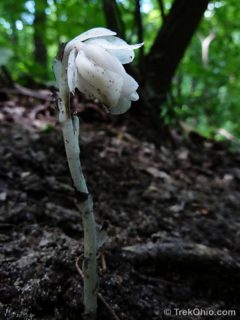 The white flower above is known by several names: Indian pipe, Ghost plant and Corpse plant. Like squawroot, Indian pipe can't meet its own nutritional needs since it has no chlorophyll. It leads a parasitic life just as squawroot does.
While squawroot gets its nutrition by directly tapping into the roots of oak trees, Indian pipe gets its nutrition more indirectly. It's host organism is a fungus, a member of the Russulaceae family. This fungus gets its nutrition from tree roots. However Read more ➜
The white flower above is known by several names: Indian pipe, Ghost plant and Corpse plant. Like squawroot, Indian pipe can't meet its own nutritional needs since it has no chlorophyll. It leads a parasitic life just as squawroot does.
While squawroot gets its nutrition by directly tapping into the roots of oak trees, Indian pipe gets its nutrition more indirectly. It's host organism is a fungus, a member of the Russulaceae family. This fungus gets its nutrition from tree roots. However Read more ➜ Indian pipe: Another plant without chlorophyll
 The white flower above is known by several names: Indian pipe, Ghost plant and Corpse plant. Like squawroot, Indian pipe can't meet its own nutritional needs since it has no chlorophyll. It leads a parasitic life just as squawroot does.
While squawroot gets its nutrition by directly tapping into the roots of oak trees, Indian pipe gets its nutrition more indirectly. It's host organism is a fungus, a member of the Russulaceae family. This fungus gets its nutrition from tree roots. However Read more ➜
The white flower above is known by several names: Indian pipe, Ghost plant and Corpse plant. Like squawroot, Indian pipe can't meet its own nutritional needs since it has no chlorophyll. It leads a parasitic life just as squawroot does.
While squawroot gets its nutrition by directly tapping into the roots of oak trees, Indian pipe gets its nutrition more indirectly. It's host organism is a fungus, a member of the Russulaceae family. This fungus gets its nutrition from tree roots. However Read more ➜ 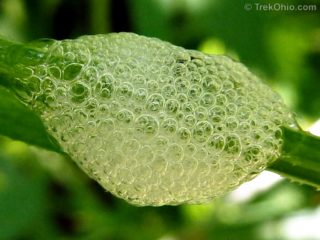 While we were hiking at Caesar Creek Gorge State Nature Preserve, I happened across this frothy, little mess.
I had previously encountered this bubbly stuff on grass.
It turns out that this is the work of a spittlebug, and you are looking at his spittle.
Okay, it's not exactly spittle. The spittlebug youngsters (called nymphs) tap into plants and suck their sap. According to this Wikipedia article, while consuming sap the nymphs use the "excess, filtered fluids" to produce
While we were hiking at Caesar Creek Gorge State Nature Preserve, I happened across this frothy, little mess.
I had previously encountered this bubbly stuff on grass.
It turns out that this is the work of a spittlebug, and you are looking at his spittle.
Okay, it's not exactly spittle. The spittlebug youngsters (called nymphs) tap into plants and suck their sap. According to this Wikipedia article, while consuming sap the nymphs use the "excess, filtered fluids" to produce 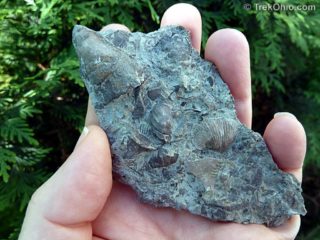 This past weekend, Bob and I went to Caesar Creek State Park to do a little hiking. However once we got there, we happened upon this amazing spillway that was just full of fossils.
In case you are wondering, this is basically a gigantic ditch. The Army Corps of Engineers constructed it to safely channel water from the Caesar Creek Reservoir in the event of flooding. The floor and one wall of the spillway consists of limestone and shale bedrock (dolomite).
The bare bedrock
This past weekend, Bob and I went to Caesar Creek State Park to do a little hiking. However once we got there, we happened upon this amazing spillway that was just full of fossils.
In case you are wondering, this is basically a gigantic ditch. The Army Corps of Engineers constructed it to safely channel water from the Caesar Creek Reservoir in the event of flooding. The floor and one wall of the spillway consists of limestone and shale bedrock (dolomite).
The bare bedrock 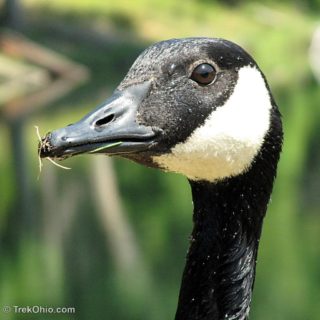 I have had the good fortune of vacationing in Canada on a couple of occasions, and one thing that became immediately clear to me is that Ohio has way more Canada Geese than Canada has. It's possible to go an entire day in Canada and not even see a Canada Goose. Let's see you manage that in Ohio!
Given that Ohio appears to be the center of the Canada Geese population, I suggest that we rename them Ohio Geese, or since Ohioans go by the nickname, "Buckeyes," maybe we could call them Buckeye Geese.
My
I have had the good fortune of vacationing in Canada on a couple of occasions, and one thing that became immediately clear to me is that Ohio has way more Canada Geese than Canada has. It's possible to go an entire day in Canada and not even see a Canada Goose. Let's see you manage that in Ohio!
Given that Ohio appears to be the center of the Canada Geese population, I suggest that we rename them Ohio Geese, or since Ohioans go by the nickname, "Buckeyes," maybe we could call them Buckeye Geese.
My 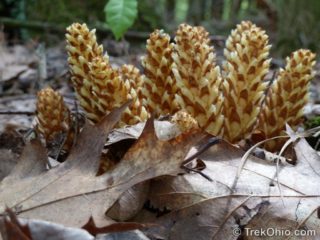 When other seeds germinate, the seedlings struggle to emerge into the sunlight, so they can photosynthesise and make their own nutrition. When a squawroot seed germinates, it squirms farther underground in search of its nourishment. It "feels around" in the dark until it finds the root of an oak or beech tree and latches on for dear life. For the rest of its life it will feed parasitically off these tree roots. The oak roots develop little, knobby protuberances where the squawroot has latched on,
When other seeds germinate, the seedlings struggle to emerge into the sunlight, so they can photosynthesise and make their own nutrition. When a squawroot seed germinates, it squirms farther underground in search of its nourishment. It "feels around" in the dark until it finds the root of an oak or beech tree and latches on for dear life. For the rest of its life it will feed parasitically off these tree roots. The oak roots develop little, knobby protuberances where the squawroot has latched on, 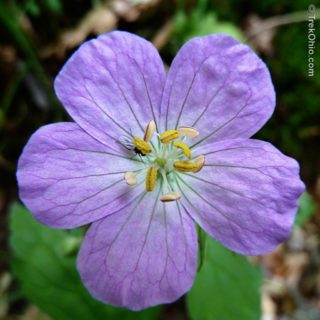 This post features assorted, spring flowers that I photographed this past April in Ohio that did not have spiders on them. Click on a flower if you'd like to see a larger version of it. Hovering over each photo with your mouse will display the species name if I've managed to identify it (Update: I've since gone back and added an identifying caption after each pair of flowers). If you can identify any of the mystery flowers, I'd love to hear from you in the comments.
This post features assorted, spring flowers that I photographed this past April in Ohio that did not have spiders on them. Click on a flower if you'd like to see a larger version of it. Hovering over each photo with your mouse will display the species name if I've managed to identify it (Update: I've since gone back and added an identifying caption after each pair of flowers). If you can identify any of the mystery flowers, I'd love to hear from you in the comments.
 By visiting Blackhand Gorge Nature Preserve, you can trace Ohio's long history of transportation.
Native Americans navigated the Licking River for centuries before the arrival of European settlers. There is a cliff made of Blackhand sandstone rising on the north side of the Licking River. In prehistoric times, Native Americans inscribed a petroglyph on this cliff; it looked like a very large, black hand. Not only is the gorge named after this petroglyph, but the class of erosion-resistant sandstone
By visiting Blackhand Gorge Nature Preserve, you can trace Ohio's long history of transportation.
Native Americans navigated the Licking River for centuries before the arrival of European settlers. There is a cliff made of Blackhand sandstone rising on the north side of the Licking River. In prehistoric times, Native Americans inscribed a petroglyph on this cliff; it looked like a very large, black hand. Not only is the gorge named after this petroglyph, but the class of erosion-resistant sandstone 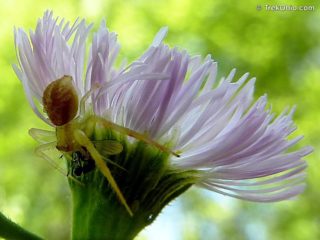 Since my last post on an Ambush Predator in a Flower, I've started keeping an eye out for crab spiders when doing macro shots of wildflowers. Yesterday I not only photographed two more crab spiders, but I've captured the moment immediately after the spider has seized its prey.
The bottom photo is a little harder to make out, so let me describe what's going in that one. The crab spider is to the left of the flower's center. The small insect the spider is eating is identical to the one
Since my last post on an Ambush Predator in a Flower, I've started keeping an eye out for crab spiders when doing macro shots of wildflowers. Yesterday I not only photographed two more crab spiders, but I've captured the moment immediately after the spider has seized its prey.
The bottom photo is a little harder to make out, so let me describe what's going in that one. The crab spider is to the left of the flower's center. The small insect the spider is eating is identical to the one 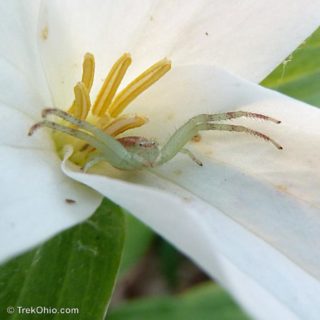 Yesterday I was exploring Knox Woods State Nature Preserve when I encountered the little creature pictured above. To be honest, I didn't even know I had encountered him at first. I was on my way out of the woods because the sun was setting. On a whim I casually took a quick photo of a trillium just because it was adjacent to the trail. I hadn't been looking at any of my shots after taking them since I was trying to conserve my battery power, but on another whim I looked at this one anyway.
As
Yesterday I was exploring Knox Woods State Nature Preserve when I encountered the little creature pictured above. To be honest, I didn't even know I had encountered him at first. I was on my way out of the woods because the sun was setting. On a whim I casually took a quick photo of a trillium just because it was adjacent to the trail. I hadn't been looking at any of my shots after taking them since I was trying to conserve my battery power, but on another whim I looked at this one anyway.
As 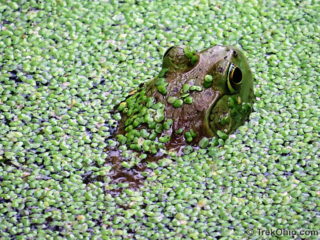 I had no idea how to tell whether a green frog was male or female, but now I do. And if you check out one of the off-site posts below, you'll know too. 🙂
See either:
https://naturallycuriouswithmaryholland.wordpress.com/2013/08/15/a-frogs-tympanum/, orhttps://sillyfrogsusan.wordpress.com/2012/04/20/nature-knowledge-frog-gender-id/
I had no idea how to tell whether a green frog was male or female, but now I do. And if you check out one of the off-site posts below, you'll know too. 🙂
See either:
https://naturallycuriouswithmaryholland.wordpress.com/2013/08/15/a-frogs-tympanum/, orhttps://sillyfrogsusan.wordpress.com/2012/04/20/nature-knowledge-frog-gender-id/